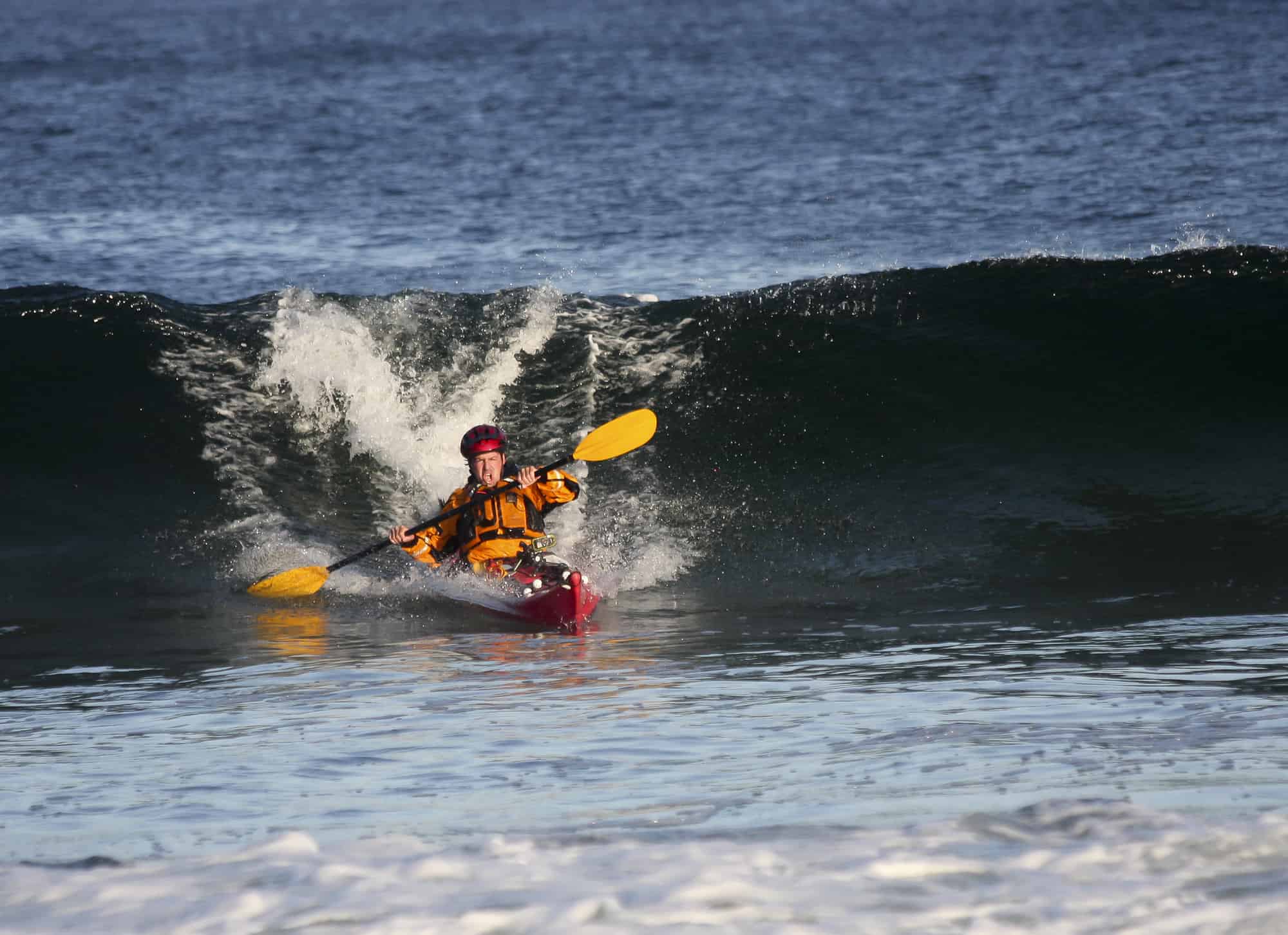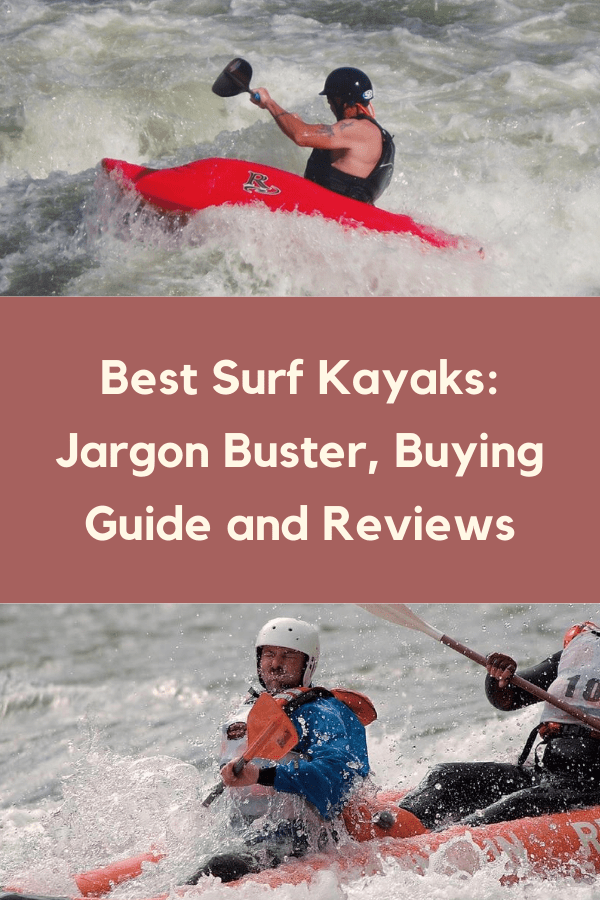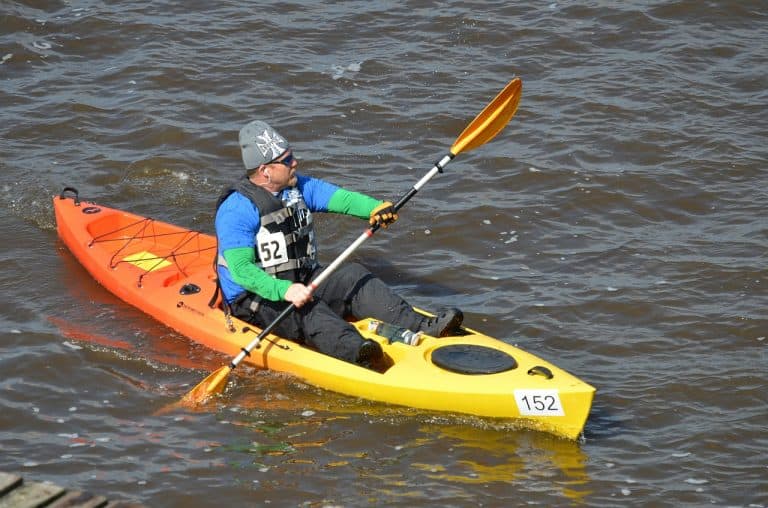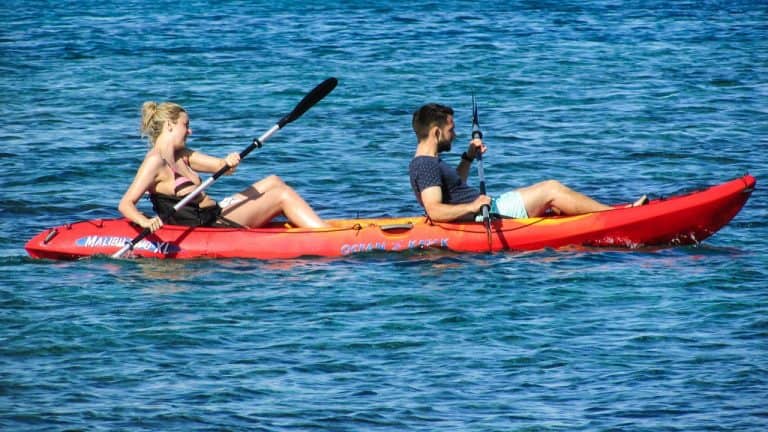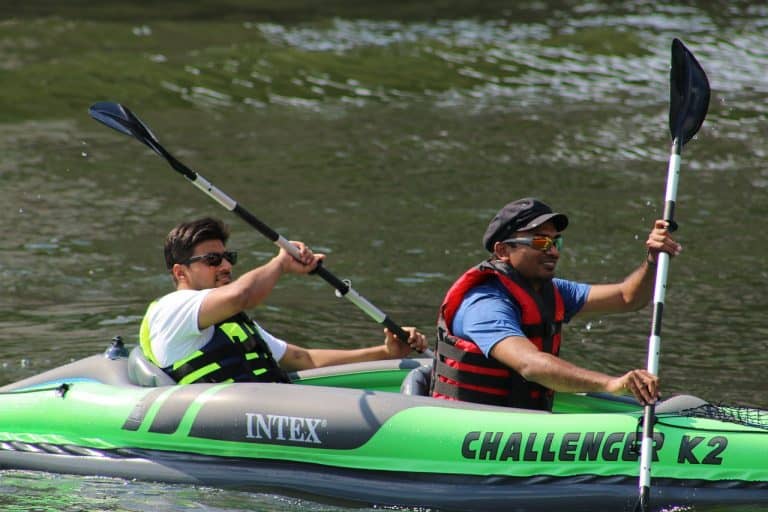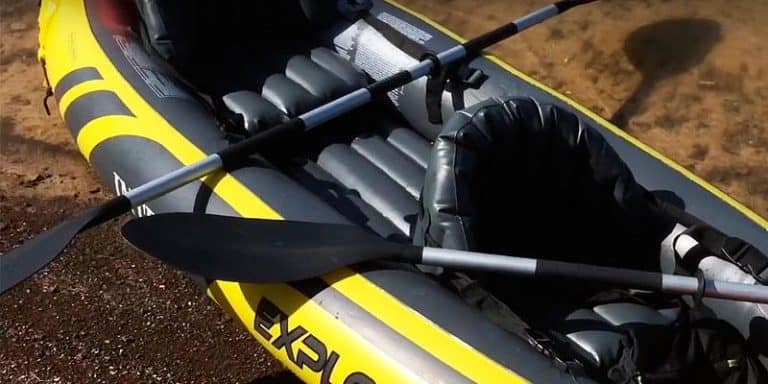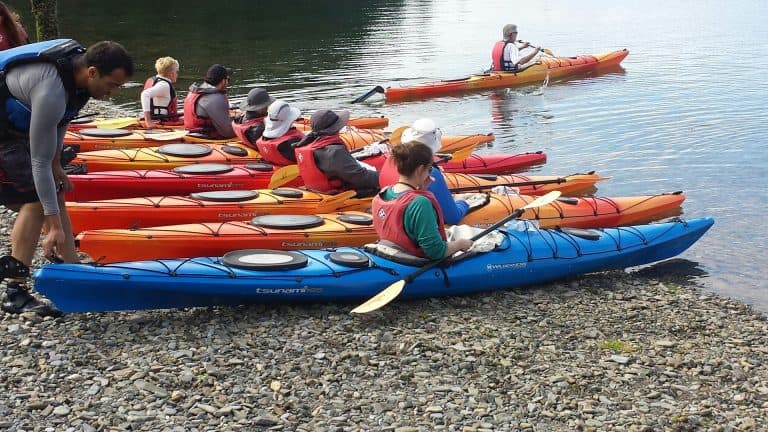At its most straightforward definition, kayak surfing is a mixture of surfboarding and whitewater kayaking.
The aim is still to catch large waves and plane across the front of them, but unlike surfboarding, you are sitting down in the traditional kayaking position.
The benefit of using a surf kayak and a kayaking paddle is that the surf kayaker has greater control in comparison to a surfboard. This is because of the kayaker’s greater ability to control their direction of travel and the kayak’s lower center of gravity.
This allows the surf kayaker to plane across the front of the wave for longer by adjusting their direction, and catch a larger surf because of their inherently greater stability.
Dedicated surf skis have only been in production since the mid-70s, and there is still a limited number of models available. However, because of similarities in design, some whitewater playboats can also be used in surf kayaking.
Picking which boats work best can be complicated if you don’t know what to look for, so we’ve put together a jargon buster to simplify the terminology, a buying guide to highlight what to look for when buying one, and reviews of some of the best surf kayaks available.
Best Surf Kayaks
- Riot Kayaks Boogie 50 – Editors Choice
- Riot Kayaks Thunder 65
- Dagger Jitsu 6.0 Kayak
- Riot Kayaks Astro 54
- Riot Kayaks Magnum 72
Kayak Surfing Jargon Buster
Waterline
The waterline is the length of the kayak that is submerged in the water. This dictates how fast the kayak is and how easy it is to turn. The higher the rocker of a kayak, the shorter the waterline.
Rocker
The rocker refers to the upward tilt of a kayak at the bow and stern. The more rocker a boat has, the more maneuverable it is. The flatter the rocker is, the more speed a boat will pick up and its tracking will be better.
Edging
Edging, also called carving, is the act of tilting a kayak so that one side of the kayak is out of the water. Carving a kayak into a turn creates more water friction on one side of the kayak, causing it to turn faster.
Planing Hull
The planing hull has a mostly flat surface below the water allowing the kayak to skim across the surface of the water, adding to its agility and manoeuvrability.
On flat water, the lack of a displacement stops a planing hull from cutting through the water and slows it down significantly.
Displacement Hull
A displacement hull design has a V-shaped section that “cuts” into the water. This allows a displacement hull to pick up greater speed on flatter water but cuts down on its manoeuvrability in whitewater as it lacks the ability to skim across the top of the water.
Chines
Chines are the section of the boat’s hull that sits below the waterline and have a drastic effect on how a kayak handles. They tend to come in one of two designs:
- Hard Chines: Hard-chined kayaks have rigidly defined contours below the waterline. The benefit of this definition is that they provide better control and agility. But this enhanced agility comes at a cost. Hard chines can get caught on obstacles and cause the boat to overbalance. They also make the kayak more responsive to currents and changes in water flow, which reduces the boat’s stability.
- Soft Chines: A kayak with soft chines has a rounded hull below the waterline. While this increases the kayak’s stability, it does so at the cost of manoeuvrability. Soft-chined boats require firmer input when paddling or steering, and are more difficult to edge into tight turns or manoeuvres.
Buying Guide
Hull Shape
Because of their need to plane across the surface of the wave, surf kayak hulls are often flattened with little displacement. Kayaks with a more extended waterline and larger displacements, such as sea or touring kayaks, are designed to cut through the wave rather than ride with it.
When selecting a surf kayak, look for a low displacement planing hull, ideally with built in fins, or a skeg, to allow for greater agility.
Volume
Volume is slightly more important to surf kayaks than it is to other kayak types. It contributes to how much gear you can store and the maximum weight the craft can take, but it also has more technical uses.
In surf kayaks, as in all whitewater kayaks, the amount of volume and its distribution affect the way the kayak handles.
For instance, playboats have extremely low volumes with the center of gravity firmly in middle of the kayak to keep it balanced while performing tricks.
By comparison, the volume on surf kayaks tends to be gathered towards the bow, lending them extra speed when riding a wave.
Low Rocker
While some whitewater craft can be used as surf kayaks, not all models are universally useful. If you can’t find a specially designed surf kayak, then playboats with a low rocker make a useful substitute.
By combining a low rocker with a planing hull, whitewater playboats are able to pick up waves and plane along the front of them in a similar style to a surf kayak.
Avoid creekboats or river running boats as these tend to have a high rocker to keep them manoeuvrable so they can navigate sharp turns.
Accessories
Like all whitewater kayaks, using a surf kayak also means bringing and using the right accessories to make you as safe as possible.
When selecting a surf kayak, bear in mind that you will need to purchase some variation of the following necessities, and look for brands of kayaks that provide at least one of them.
- A Personal Floatation Device: When buying a PFD for surf kayaking, it is vital to find one that fits snugly while not restricting your movement. A properly fitted PFD will allow you to freely move your upper body and shoulders while being snug enough that there is no danger that it will be ripped loose during a wipeout.
- A Whitewater Rated Helmet: Not all kayaking helmets are rated for whitewater or kayak surfing. When looking to buy a helmet, and you will need one, make sure that it is correctly rated.
- A Reinforced Paddle: Most kayaking paddles are not built to withstand repeated impact with the surf line. When buying a paddle for surf kayaking, look for the reinforced paddles used with creekboats or playboats that are designed to be impact resistant.
Best Surf Kayak Reviews
1. Riot Kayaks Boogie 50
Hull: Polyethylene
Length: 7’ 9”
Width: 24.7”
Cockpit Dimensions: 32” x 17”
Volume: 189 L
The Boogie 50 is explicitly designed as a surf kayak, letting the paddler capture the power of the waves and navigate around rocky coasts. The Boogie’s planing hull is narrow and has a low rocker, allowing it to quickly accelerate and achieve speeds that you just won’t get with other whitewater kayaks.
The squashed back end, sharp rails, and long narrow nose allow for excellent acceleration, fantastic carving, and enough room for even the tallest of paddlers to stretch their legs out.
Shapeable foam foot-blocks keep the cockpit fit snug, giving you extra control in tighter turns. Front and rear carry handles make it easy to haul it in and out of the surf.
To keep the Boogie tracking straight, it features three fins built into the hull and has excellent lateral stability to keep you upright when the wave breaks.
The Boogie is fitted with a surfing “power seat” which allows you more leverage and control. Padded thigh braces on the inner hull keep you comfortable as you lean into tight turns.
If the Boogie has one drawback, it is that the lack of a tether attachment or thigh straps means it can occasionally get away from you if flipped in heavy surf.
PROS
CONS
Summary: If you’re looking for a surf kayak that’s fast, responsive, and stable, then the Boogie 50 is ideal. It accelerates fast, planes easily, and its tri-fin design keeps it agile when you’re on the waves.
The power seat and customizable cockpit fit give you fantastic control over the kayak and keep you in the driving seat, even on the biggest waves.
2. Riot Kayaks Thunder 65
Hull: Polyethylene
Length: 7’8”
Width: 25.5”
Cockpit Dimensions: 32” x 18”
Volume: 256 L
The Thunder 65 is designed with speed in mind; it’s beveled edges and flat, shallow hull allow it to catch the wave while its short length and great manoeuvrability help to keep it in the sweet spot.
The secure fit of its cockpit enhances the paddler’s control over this nippy little boat. The adjustable unity seating system can be swapped out for a surfing power seat while adjustable foot braces and sure-grip thigh braces keep the kayaker stable, allowing them to carve into turns using their lower body.
When not on the waves, the rudder keeps the Thunder tracking straight despite its planing hull, although this may have to be removed in heavy surf as it is less durable than plastic fins.
At just 48 pounds and fitted with rubberized carry handles, the Thunder is easy to transport and get down to the surf. Its built in security bar means it can sit in the sand without you needing to keep an eagle eye on it.
PROS
CONS
Summary: If you are looking for a speed boat that can handle the waves as easily as it can handle whitewater river runs, then the Thunder is an excellent choice.
Although not specifically designed for surf kayaking, its planing hull allows it to catch the surf, making it a unique crossover craft for those looking to enjoy whitewater at the coast as well as on the river.
3. Dagger Jitsu 6.0 Kayak
Hull: Polyethylene
Length: 6’
Width: 27”
Cockpit Dimensions: 34” x 19”
Volume: 239 L
Agile and responsive, the Dagger Jitsu 6.0 is designed as a trick boat. Its hard chines and planing hull keep it fast and maneuverable on the water, and allow the kayaker to throw it into tight turns.
At just 6 feet long and weighing only 38 pounds, the Jitsu is easy to carry and easy to store. You wont need to worry about getting a trolley to transport this kayak to the beach.
The only real downside to the Jitsu is its poor flatwater performance. Designed to use the waves to pick up speed, the Jitsu struggles with tracking and pace when it’s not riding the surf.
Its short length and planing hull means it will also struggle to maintain control in a kind of rough weather.
PROS
CONS
Summary: The Jitsu is an excellent playboat that is right at home in the surf where its agility allows the kayaker to turn the power of the waves into impressive tricks.
If you’re looking for performance in any other kind of environment then you’ll need to look elsewhere.
4. Riot Kayaks Astro 54
Hull: Polyethylene
Length: 6’2”
Width: 25”
Cockpit Dimensions: 33” x 18”
Volume: 204 L
The Astro 54 is the smallest and lightest of the kayaks on our list and is designed primarily as a playboat.
It’s a fantastic craft if you are looking to use the strength of the surf to perform tricks or if the surf in your area is broken and uneven.
At only 38 pounds and just over 6 feet in length, the Astro is responsive, agile, and a breeze to transport. All this makes it ideal if you are looking for a kayak you can take out on the surf without needing to do too much planning.
Like the Thunder, the Astro has a surfing power seat with adjustable foot braces and sure-grip thigh braces designed to keep you snug in the cockpit.
The real downside to the Astro is part of one its greatest strengths; its small size keeps it manoeuvrable, but also restricts the size of the kayaker. The weight range of the Astro is between 110 and 180 pounds.
PROS
CONS
Summary: If your local surfing scene is about tricks and taking advantage of short choppy surf to perform them, then the Astro is an ideal choice.
If you are looking for a kayak to take on longer surf, then you may find that the Astro’s short length and high rocker make it unstable and would be better off looking at the Boogie 50.
5. Riot Kayaks Magnum 80
Hull: Polyethylene
Length: 8’ 4”
Width: 26.5”
Cockpit Dimensions: 34” x 20”
Volume: 303 L
The Riot Magnum 80 is a creekboat designed with extra stability in mind, allowing beginners to experience a whitewater or kayak surfing while providing an element of security.
The displacement hull cuts through the water, keeping the Magnum moving fast while the high rocker keeps it manoeuvrable. This is both a benefit and a drawback as the Magnum may not be able plane across the front of a wave in the way the other kayaks with planing hulls would.
The Magnum has soft chines which keep the boat more stable, but you will need to be a little firmer with the paddle to get the boat to accept input.
At 45 pounds, the Magnum certainly isn’t heavy, which will come as a great relief if you have to carry it for any real distance.
PROS
CONS
Summary: The Magnum is a great multi-purpose boat, allowing you to take on a variety of whitewater runs while still being able to surf. The multi-chine hull adds excellent stability, making it the perfect boat for beginners to start whitewater running or surfing in.
If you are looking for a jack-of-all-trades boat that can handle any whitewater you point it towards, then the Magnum is what you’re after.
Just bear in mind that it won’t perform as well as kayaks that are specifically designed for a particular environment.
Our Pick –Riot Kayaks Boogie 50
The Riot Boogie 50 is our pick for best surfing kayaks because it has everything the budding kayak surfer needs.
It’s agile, responsive, accelerates quickly, and stays fast. Its excellent cockpit is set up for stability and allows the paddler to torsion their lower body, powering in tight, carving turns, or shifting their center of gravity to stay in the wave’s sweet spot.
If you’re out in heavy surf, the Boogie’s built in tri-fin set up and high lateral stability help to keep your kayak from flipping.
What happens after you flip is one of the few drawbacks of the Boogie, as without a tether attachment or thigh-straps it’s all too easy to lose your kayak in the surf after a wipeout.
However, as tethers and thigh-straps can be bought as optional extras, this is an easy fix and the overwhelming number of positive features the Boogie has makes it the natural choice for our pick of surfing kayak..

